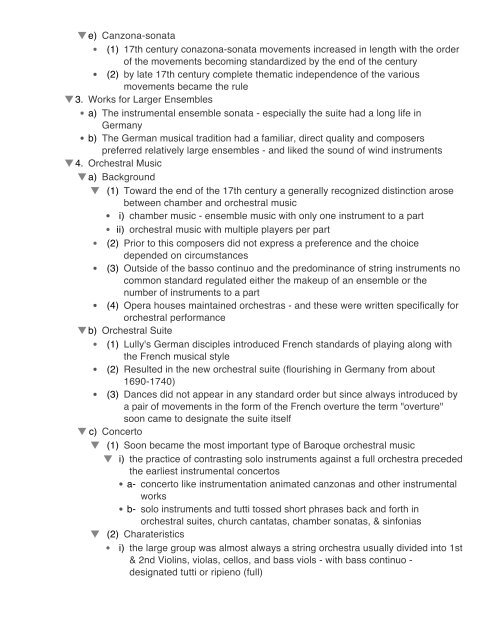An Outline of The History of Western Music Grout ... - The Reel Score
An Outline of The History of Western Music Grout ... - The Reel Score
An Outline of The History of Western Music Grout ... - The Reel Score
Create successful ePaper yourself
Turn your PDF publications into a flip-book with our unique Google optimized e-Paper software.
e) Canzona-sonata<br />
(1) 17th century conazona-sonata movements increased in length with the order<br />
<strong>of</strong> the movements becoming standardized by the end <strong>of</strong> the century<br />
(2) by late 17th century complete thematic independence <strong>of</strong> the various<br />
movements became the rule<br />
3. Works for Larger Ensembles<br />
a) <strong>The</strong> instrumental ensemble sonata - especially the suite had a long life in<br />
Germany<br />
b) <strong>The</strong> German musical tradition had a familiar, direct quality and composers<br />
preferred relatively large ensembles - and liked the sound <strong>of</strong> wind instruments<br />
4. Orchestral <strong>Music</strong><br />
a) Background<br />
(1) Toward the end <strong>of</strong> the 17th century a generally recognized distinction arose<br />
between chamber and orchestral music<br />
i) chamber music - ensemble music with only one instrument to a part<br />
ii) orchestral music with multiple players per part<br />
(2) Prior to this composers did not express a preference and the choice<br />
depended on circumstances<br />
(3) Outside <strong>of</strong> the basso continuo and the predominance <strong>of</strong> string instruments no<br />
common standard regulated either the makeup <strong>of</strong> an ensemble or the<br />
number <strong>of</strong> instruments to a part<br />
(4) Opera houses maintained orchestras - and these were written specifically for<br />
orchestral performance<br />
b) Orchestral Suite<br />
(1) Lully's German disciples introduced French standards <strong>of</strong> playing along with<br />
the French musical style<br />
(2) Resulted in the new orchestral suite (flourishing in Germany from about<br />
1690-1740)<br />
(3) Dances did not appear in any standard order but since always introduced by<br />
a pair <strong>of</strong> movements in the form <strong>of</strong> the French overture the term "overture"<br />
soon came to designate the suite itself<br />
c) Concerto<br />
(1) Soon became the most important type <strong>of</strong> Baroque orchestral music<br />
i) the practice <strong>of</strong> contrasting solo instruments against a full orchestra preceded<br />
the earliest instrumental concertos<br />
a- concerto like instrumentation animated canzonas and other instrumental<br />
works<br />
b- solo instruments and tutti tossed short phrases back and forth in<br />
orchestral suites, church cantatas, chamber sonatas, & sinfonias<br />
(2) Charateristics<br />
i) the large group was almost always a string orchestra usually divided into 1st<br />
& 2nd Violins, violas, cellos, and bass viols - with bass continuo -<br />
designated tutti or ripieno (full)<br />
ii) solo instruments were also usually strings - violin for the solo concerto, most<br />
<strong>of</strong>ten 2 violins w/continuo in the concerto grosso (other instruments might be<br />
added or substituted





